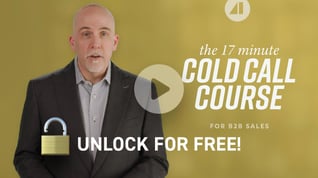B2B salespeople have been taught and trained that their company and their offerings are what make them different from their competitors. The marketing function of most sales organizations provide sales reps with a stunningly beautiful slide deck to accompany the salesperson's first meeting. This slide deck and the conversation answers the question “Why us?” even though no B2B customers are asking that. This conversation ends with a question about the decision maker's pain points.
When you sit down across from a decision-maker and talk about your company, your clients, and your offerings, you are wasting your prospective client's time. When your competitor follows you two days later, your prospective client is treated to another timewaster, one indistinguishable from yours.
The goal of this legacy sales process is to differentiate you and position the sales organization and their "products and services" as unique in the industry. However, since most salespeople follow this same outdated sales strategy, instead of differentiating, you prove yourself and your company to be a commodity.
The Evolution of B2B Sales
When buyers have new needs, sales organizations must evolve their strategies to meet them. When you continue with the old ways, you will struggle with deals you might have won had you done something different.
If you are still saddled with this outdated and ineffective sales approach, immediately start to explore new sales strategies that are designed to work in the current environment. If you have trouble building a pipeline or closing deals, a large part of those challenges can be laid at the feet of these older sales approaches. No 21st-century company needs a 20th-century sales approach. Too much has changed.
The Critical Strategy to Differentiate the Salesperson
The outdated sales approach provides a salesperson’s ideal customer with information that isn't valuable. Company history and a run-down of offerings are readily available on the sales organization’s website. This approach is like having the salesperson read their client a brochure. We describe this salesperson as One-Down, as they lack the ability to create value for their clients in the sales conversation.
The most important strategy salespeople need to differentiate themselves is information disparity. Information disparity means that the B2B salesperson has knowledge and experience that their multiple stakeholders are missing. We describe this salesperson as being One-Up, possessing the ability to use a set of value-creation strategies that cause their prospective clients to prefer to spend time with and, eventually, buy from them.
While you can't differentiate yourself by talking about your company, you can easily and effectively do so by providing a better sales experience, something that will allow you to stand out. The sales conversation is the only vehicle you have to create value for your prospective clients. In a competitive selling scenario, offering your contact something they value in the first meeting will probably dispatch your competitors.
Here is the easiest way to understand what value creation in the sales conversation is: You educate your contacts on how to make a decision that enables them to get the results they need. You do this by giving them counsel, advice, and recommendations in all the areas that will be helpful to them, including how to buy. The salesperson who uses this approach will win the client's business, even when they are up against larger sales organizations.
How to Win Deals and Differentiate Your Company
One of the things we worry about here at thesalesblog.com is the lack of business acumen on most B2B sales teams. To be One-Up and create value for your clients, you need to lead a conversation that makes you sound and feel like a business advisor. When you are consultative, you are literally telling your contacts what they need to do to improve their business results. Given a choice between trying to speed up the B2B sales cycle and trying to improve your business acumen, you’re better off improving your business acumen. Your client doesn't find value in your rush to close a deal.
To differentiate your company using an effective, professional approach, you need to ditch the "Why us?" slide deck and gain the business acumen. This will enable you to talk about the different business models in your industry, better position your company, and deliver the value your clients need once they buy from you.
In Elite Sales Strategies: A Guide to Being One-Up, Creating Value, and Becoming Truly Consultative, you will find a chapter on triangulation strategy, one of the more powerful ways to differentiate your company and your offerings while eliminating your competitors without ever mentioning their names. Instead, you provide an understanding of how each delivery model works. To use this strategy, you start by saying what's good about the model before describing its downside, something you can position as the concessions built into the model. No matter where your model is on this continuum, from low price to bleeding edge, you describe your model last, explaining how it prevents the concessions the client would otherwise not recognize until they experience the buyer's remorse that comes from not having a salesperson who could educate the decision makers and their stakeholders.
Different Differentiate in the Modern Sales Approach
The best and most effective way to differentiate yourself in sales is to become One-Up and practice a set of strategies designed to create value for your potential customers. By helping them learn what they need to know during the sales conversation, they can improve their business results. You can differentiate your company by using a triangulation strategy to explain the different ways companies in your industry create value for their clients, positioning your company's model as the one best for your clients.
Alvin Toffler wrote: “The illiterate of the twenty-first century will not be those who cannot read and write, but those who cannot learn, unlearn, and relearn.” If it's time to unlearn, start here.













